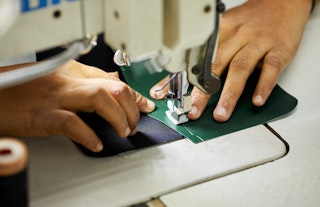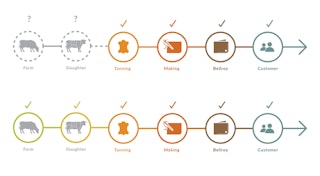よりよい世界につながる事業(最新版)
よりよい世界を目指すベルロイの2023年度の活動と歩み
毎年、ベルロイでは、地球への影響を最小限に抑えるため、さまざまな決定を行っています。これに関するベルロイの進捗状況は、2023年度最新情報をご覧ください。
お支払方法

We’re working towards a future in which people, animals and the planet sustain each other. And that means making decisions with the greatest consideration for all of those stakeholders. As a brand that uses leather, we very quickly realized work was needed to better the industry for the animals that are part of it.

Bellroy started as a wallet company. Leather wallets, to be exact. So it was only natural that we became passionate about leather itself. Making the highest possible quality wallets that could stand the test of time (and look great doing so) meant sourcing the highest quality leather we could find.


In 2015, we began sourcing leather exclusively from tanneries that had earned the highest rating from the Leather Working Group (LWG). Which means that, compared to standard tanneries, these tanneries consume about 75% less water, use less power and produce significantly less waste and effluent. They also abide by strict labor and working conditions regulations. Better tanneries, better leather.



The LWG’s auditing was comprehensive when it came to environmental impact from hide to finished leather. But it didn’t take into account what comes before the tannery. It was nearly impossible to trace the origin of the hides arriving at our supplier tanneries.
The plain truth is that, as a by-product of the beef industry, leather comes from cattle. And the lack of traceability from the tannery back to the farm meant we had little visibility on the welfare of those animals. Not great.

Bothered by this, our team, along with other concerned LWG members, began advocating for more traceability in the industry.
Bellroy was in a unique position to lead - as a small company, the amount of leather we used meant we could be nimble and selective with our choice of suppliers.
“The reality is, we (as a society) have long prioritized humanity over the planet and animals. And we have made great progress bringing humans out of extreme poverty, improving child mortality, improving life metrics... but often it’s been at the expense of animals or the planet. At Bellroy, we believe that when we make decisions for people, animals or the environment without balancing the benefits and consequences of all three, those sacrifices compromise the vibrancy of our future. So now we have to broaden the lens and say, how can we work towards a system where those three stakeholders can nurture each other? So, for leather, the value of leather for us is that it’s still one of the best materials for our products in terms of longevity, use and lack of petrochemical input. Acknowledging that, we want to work hard to improve the animal welfare standards within the entire supply chain and minimize the sacrifice as much as possible.” – Andy Fallshaw, Bellroy s co-founder


This advocacy led to the formation of the Animal Welfare Group (AWG) in 2016, a separate group of companies within the LWG whose focus was to provide information and education about the supply chain, to help companies make good choices about suppliers.
At the first annual general meeting of the AWG in 2017, Bellroy’s General Counsel Sarah Nichols was elected chair. Bellroy was in a unique position to lead – as a small company (compared to the giant automotive, footwear and fashion brands also in the AWG), the amount of leather we used meant we could be nimble and selective with our choice of suppliers.
The LWG s auditing [...] didn t take into account what comes before the tannery. It was nearly impossible to trace the origin of the hides arriving at our supplier tanneries.
In her time as chair, Sarah has seen the leather industry up close, in-person. From herding cattle in Texas with a rancher named Pistol, to touring abattoirs and tanneries.


“When we started the AWG it was pretty controversial… we were barely allowed to say the word ‘animal’. The industry had this concept that ‘leather starts when the hide hits the floor’. So we basically “encouraged” them to acknowledge that what comes before that moment – aka the welfare of the cattle – is, in fact, a huge part of the leather industry. And there was definitely pushback… tension between the old-school guys and the new young progressive folks. But it was amazing how quickly those “old-schoolers” came to the party, and are now some of our biggest proponents. Since then animal welfare has gone from the fringe to the mainstream. The industry understands now that customers care about the whole supply chain. The vast majority of major brands now consider animal welfare in the same way they would labor conditions.” – Sarah Nichols
This year the AWG will cease to exist, which sounds bad but is actually a huge win. Rather than being a separate entity, it will become a standard sub-group of the LWG itself.
The mission of the AWG: traceability. The outcome (so far): a standardized system of criteria that help measure and compare the traceability of the cattle industry across countries. To date we’ve helped create profiles of 24 hide-producing countries, showcasing the state of animal welfare and a due-diligence rating for each. This means the LWG can better trace hides from tannery back to slaughterhouse. And, since hides are a byproduct of the beef industry, and beef (being intended largely for human consumption) is highly regulated, tracing from slaughterhouse to farm is already very accurate in a lot of countries. This nearly closes the gap, meaning leather purchasers can now have confidence in the traceability of leather from farm onward.


And while that’s a lot of progress in a short time span, 2023 has even bigger things in store. This year the AWG will cease to exist, which sounds bad but is actually a huge win. Rather than being a separate entity, it will become part of the Traceability Working Group, which is a standard sub-group of the LWG itself. So, instead of animal welfare being treated as a standalone issue, it will now be considered part of the whole ecosystem of leather production. And for the first time, animal welfare will be one of the criteria assessed in a tannery’s rating.

毎年、ベルロイでは、地球への影響を最小限に抑えるため、さまざまな決定を行っています。これに関するベルロイの進捗状況は、2023年度最新情報をご覧ください。

In conversation with Dr Luke Haverhals of Natural Fiber Welding

Bellroy's bags and pouches are making the transition to recycled fabrics, and we couldn't be happier about it. We've got the answers to all your questions about our recycled fabrics, in one place.